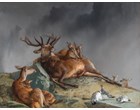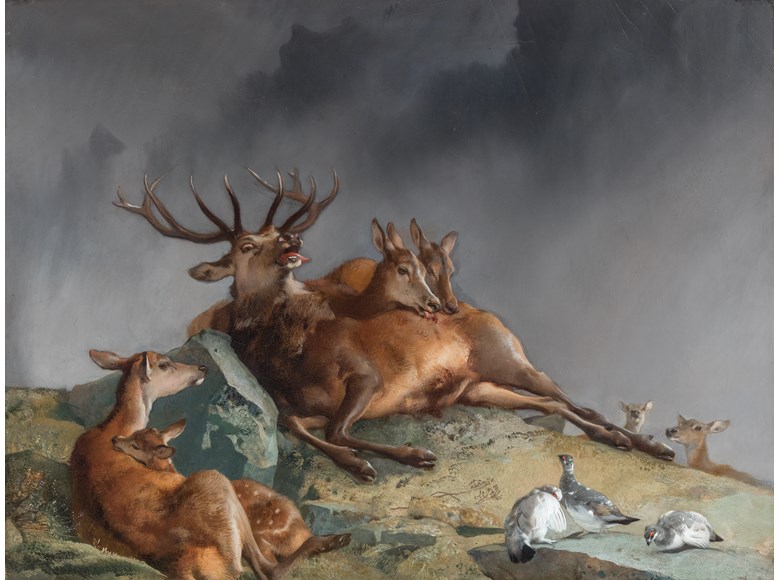 BACK TO GALLERY
BACK TO GALLERY
French & Company
Sir Edwin Landseer
The Highland Nurses
A dramatic image of family dedication and tragedy, dedicated to Florence Nightingale.
27 1/2 x 35 1/2 inches
description
On the cusp of life and death, a twelve-point stag rolls its eyes and extends its tongue in the grip of having been shot. Silhouetted against grey clouds, the doomed stag is succored by does that lick its wounds while ptarmigans peck the rocky ground.
Sir Edwin Landseer dedicated The Highland Nurses to Florence Nightingale (1820-1910), who arrived in the Crimea with a team of nurses in November 1854. Caring for wounded soldiers in unsanitary conditions, she was called the Lady with the Lamp for her nighttime rounds. An effective writer and advocate for the training of nurses, she established the Nightingale Fund in 1855 and in 1860 opened the Nightingale School, the first school for professional nursing.
Throughout his career, Landseer used animals to comment on the human condition, thereby transforming animal painting from sporting into Romantic art. The Landseer expert Richard Ormond wrote: “The deer are not ordinary animals inhabiting the natural landscape but heroic presences dominating their surroundings. Before them we sense something grander and more sublime than ourselves, an elemental force and splendor that defies the baying hounds and the stalker’s rifle.”
Landseer first visited Scotland in 1824. Impressed by the landscape and the harsh existence of the Highlanders, he returned every autumn to hunt and sketch. Highland subjects, in particular depictions of the red deer, became his specialty. Paintings such as The Challenge (Alnwick Castle) of 1844 and The Monarch of the Glen (National Gallery of Scotland) of 1851 are highpoints of Victorian art.
Landseer’s engaging personality helped him forge friendships with aristocratic landowners as well as Queen Victoria and Prince Albert, who exchanged gifts of his paintings. The artist visited Balmoral in 1850, the year he was knighted. The artist’s fame extended to the Continent, where, in 1855, he exhibited nine works at the Exposition Universelle in Paris. The critics Charles Baudelaire and Théophile Gautier praised him for his knowledge of animal form and their inner spirit. Gustave Courbet was amongst the artists influenced by Landseer, most directly in The Hunted Stag (Musée des Beaux-Arts, Marseilles) of 1861. When he died in 1873, Landseer was the most famous British artist of his generation.
Landseer claimed to have witnessed this scene. In the 1874 memorial exhibition catalogue, The Highland Nurses is discussed as follows: ‘Sir Edwin, after a day’s stalking, fired a random shot to empty his rifle barrel. At midnight, the keeper called him up, the night being moonlight to show him the incident as painted.’
Sir Edwin Landseer dedicated The Highland Nurses to Florence Nightingale (1820-1910), who arrived in the Crimea with a team of nurses in November 1854. Caring for wounded soldiers in unsanitary conditions, she was called the Lady with the Lamp for her nighttime rounds. An effective writer and advocate for the training of nurses, she established the Nightingale Fund in 1855 and in 1860 opened the Nightingale School, the first school for professional nursing.
Throughout his career, Landseer used animals to comment on the human condition, thereby transforming animal painting from sporting into Romantic art. The Landseer expert Richard Ormond wrote: “The deer are not ordinary animals inhabiting the natural landscape but heroic presences dominating their surroundings. Before them we sense something grander and more sublime than ourselves, an elemental force and splendor that defies the baying hounds and the stalker’s rifle.”
Landseer first visited Scotland in 1824. Impressed by the landscape and the harsh existence of the Highlanders, he returned every autumn to hunt and sketch. Highland subjects, in particular depictions of the red deer, became his specialty. Paintings such as The Challenge (Alnwick Castle) of 1844 and The Monarch of the Glen (National Gallery of Scotland) of 1851 are highpoints of Victorian art.
Landseer’s engaging personality helped him forge friendships with aristocratic landowners as well as Queen Victoria and Prince Albert, who exchanged gifts of his paintings. The artist visited Balmoral in 1850, the year he was knighted. The artist’s fame extended to the Continent, where, in 1855, he exhibited nine works at the Exposition Universelle in Paris. The critics Charles Baudelaire and Théophile Gautier praised him for his knowledge of animal form and their inner spirit. Gustave Courbet was amongst the artists influenced by Landseer, most directly in The Hunted Stag (Musée des Beaux-Arts, Marseilles) of 1861. When he died in 1873, Landseer was the most famous British artist of his generation.
Landseer claimed to have witnessed this scene. In the 1874 memorial exhibition catalogue, The Highland Nurses is discussed as follows: ‘Sir Edwin, after a day’s stalking, fired a random shot to empty his rifle barrel. At midnight, the keeper called him up, the night being moonlight to show him the incident as painted.’






 SEND AN EMAIL
SEND AN EMAIL
 (212) 535-3330
(212) 535-3330